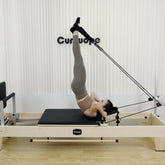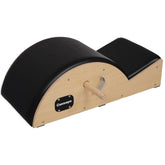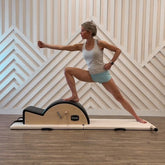Postpartum Pilates Recovery: Get Back in Shape Safely
The postpartum period is a time of significant physical and emotional change for new mothers. While the joy of welcoming a new baby is overwhelming, the process of recovery from childbirth can be challenging. Many women experience physical discomfort such as back pain, pelvic floor weakness, and changes in posture. As new mothers focus on caring for their babies, it can be easy to overlook their own health. However, it is essential to prioritize self-care, and one of the best ways to do so is ...

Why Pilates for Postpartum Recovery?
Pilates is a low-impact exercise method that emphasizes controlled movements, breathwork, and deep core engagement. It is particularly beneficial for postpartum recovery due to its focus on rebuilding core strength and improving posture, two key areas that are often weakened during pregnancy and childbirth. The gentle nature of Pilates also makes it suitable for new mothers who may still be recovering from the physical toll of labor and delivery.
During pregnancy, the body undergoes numerous changes, such as increased weight, changes in posture, and stretching of abdominal muscles. After childbirth, it is common for the muscles of the pelvic floor, abdomen, and back to remain weak, leading to discomfort or difficulty performing everyday activities. Pilates helps restore balance to the body by strengthening these muscles and improving flexibility.
Moreover, Pilates is highly adaptable. It can be modified to suit the individual needs of each mother, whether she had a vaginal delivery or a C-section, making it a safe and effective option for postpartum recovery.
The Benefits of Postpartum Pilates
1. Restoring Core Strength
The abdominal muscles undergo significant stretching and separation during pregnancy, particularly the rectus abdominis (the "six-pack" muscles). After childbirth, these muscles may remain weak or separated, a condition known as diastasis recti. Pilates focuses on strengthening the deep core muscles, which are essential for providing support to the spine and pelvis. Regaining core strength is important not only for aesthetics but also for improving posture and preventing back pain.
2. Rebuilding Pelvic Floor Strength
The pelvic floor muscles play a crucial role during pregnancy and childbirth. These muscles support the bladder, uterus, and bowel, and their strength is vital for maintaining bladder control, preventing pelvic organ prolapse, and easing the labor process. After childbirth, the pelvic floor can be weakened or overstretched, leading to issues such as incontinence or pelvic discomfort. Pilates exercises can target and strengthen the pelvic floor, improving both function and recovery.
3. Improved Posture and Alignment
During pregnancy, the body’s center of gravity shifts as the belly grows, often leading to postural imbalances. Many new mothers experience poor posture after childbirth, which can result in back, shoulder, and neck pain. Pilates emphasizes proper body alignment, and practicing Pilates regularly helps restore good posture by strengthening the muscles that support the spine and shoulders. Improved posture reduces strain on the back and helps prevent discomfort in the months following childbirth.
4. Increased Flexibility and Mobility
After childbirth, many women experience stiffness and limited mobility, particularly in the hips, lower back, and shoulders. Pilates incorporates gentle stretching and mobility exercises that help improve flexibility and range of motion. These exercises can alleviate tightness in the muscles and joints, which is particularly beneficial for new mothers who are spending a lot of time breastfeeding, carrying their baby, and performing repetitive tasks.
5. Stress Relief and Mental Well-Being
The postpartum period can be physically and emotionally taxing. New mothers may experience fatigue, anxiety, or stress as they adjust to life with a newborn. Exercise, including Pilates, is a great way to combat stress and boost mental health. Pilates encourages mindfulness and deep breathing, which can promote relaxation and improve mood. The release of endorphins during exercise also helps reduce stress and increase feelings of well-being.
6. Safe Return to Exercise
Many new mothers are eager to return to exercise after childbirth, but it is important to do so gradually and safely. Postpartum Pilates provides a low-impact way to ease back into physical activity without putting undue stress on the body. Unlike high-impact activities, Pilates emphasizes controlled movements, which are gentle on the joints and muscles. Pilates can be the perfect solution for women who are looking for a safe, effective way to rebuild strength and regain fitness after childbirth.
How to Start a Postpartum Pilates Routine
Before beginning any postpartum exercise routine, it is important to consult with your healthcare provider to ensure that you are ready to return to physical activity. Every woman’s postpartum recovery is different, and it is essential to listen to your body and go at your own pace.
Here are some tips for safely starting a postpartum Pilates routine:
1. Wait Until You Have Been Cleared for Exercise
If you had a vaginal delivery, it is typically safe to begin exercising six to eight weeks after childbirth, as long as you feel ready and have received clearance from your doctor. If you had a C-section, your recovery may take a little longer. It is essential to ensure that your body has had enough time to heal before starting a postpartum Pilates program.
2. Start Slowly and Focus on Breathing
When starting Pilates postpartum, begin with gentle exercises that focus on restoring basic movement patterns, core engagement, and breathing. Proper breathing techniques are a fundamental aspect of Pilates and can help activate the core muscles and promote relaxation. Focus on diaphragmatic breathing (breathing deeply into the abdomen) as you perform the exercises to engage your pelvic floor and deep core muscles.
3. Incorporate Pelvic Floor Exercises
A key aspect of postpartum Pilates is restoring strength to the pelvic floor muscles. Begin incorporating pelvic floor exercises such as pelvic tilts, Kegel exercises, and deep squats to improve pelvic floor function. These exercises are essential for preventing pelvic floor dysfunction and promoting overall recovery.
4. Modify Exercises as Needed
As you progress in your postpartum Pilates routine, remember that not all exercises may be suitable right away. Some exercises that involve lying flat on your back or performing intense abdominal work may be too challenging in the early stages of postpartum recovery. Work with a certified Pilates instructor who can modify the exercises to suit your current fitness level and ensure proper form and technique.
5. Be Consistent but Patient
Consistency is key to seeing progress with postpartum Pilates, but it is important to be patient with yourself. Your body has just gone through a significant physical change, and it may take time to regain strength and mobility. Aim to practice Pilates two to three times per week, gradually increasing the intensity and duration as you build strength and confidence.
Postpartum Pilates Exercises to Try
Here are some simple yet effective postpartum Pilates exercises to help you regain strength and flexibility:
1. Pelvic Tilts
- Lie on your back with your knees bent and feet flat on the floor.
- Inhale to prepare, and as you exhale, gently press your lower back into the floor, tilting your pelvis slightly upward.
- Hold for a few seconds and then release. Repeat for 10–15 repetitions.
2. Modified Plank
- Start in a tabletop position with your wrists directly under your shoulders and knees under your hips.
- Engage your core and extend one leg straight behind you, keeping your body in a straight line from head to toe.
- Hold for 10–20 seconds and then return to the starting position. Repeat on the other side.
3. Bridging
- Lie on your back with your knees bent and feet flat on the floor, hip-width apart.
- Press through your heels to lift your hips into a bridge position, squeezing your glutes and engaging your core.
- Hold at the top for a few seconds and then lower back down. Repeat for 10–15 repetitions.
4. Leg Slides
- Lie on your back with your knees bent and feet flat on the floor.
- Slowly extend one leg out straight, sliding it along the floor while keeping your lower back pressed into the mat.
- Return to the starting position and repeat with the other leg. Perform for 10–15 repetitions on each leg.
Conclusion
Postpartum Pilates is an excellent way for new mothers to safely regain strength, improve posture, and restore balance to their bodies after childbirth. By focusing on core strength, pelvic floor recovery, flexibility, and alignment, Pilates helps new mothers recover more quickly and safely, both physically and mentally. Remember to start slowly, listen to your body, and seek guidance from a certified Pilates instructor if necessary. With patience, consistency, and proper technique, postpartum Pilates ca...





